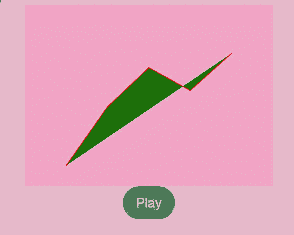harmony 鸿蒙\@AnimatableExtend装饰器:定义可动画属性
\@AnimatableExtend装饰器:定义可动画属性
@AnimatableExtend装饰器用于自定义可动画的属性方法,在这个属性方法中修改组件不可动画的属性。在动画执行过程中,通过逐帧回调函数修改不可动画属性值,让不可动画属性也能实现动画效果。也可通过逐帧回调函数修改可动画属性的值,实现逐帧布局的效果。
可动画属性:如果一个属性方法在animation属性前调用,改变这个属性的值可以使animation属性的动画效果生效,这个属性称为可动画属性。比如height、width、backgroundColor、translate属性,和Text组件的fontSize属性等。
不可动画属性:如果一个属性方法在animation属性前调用,改变这个属性的值不能使animation属性的动画效果生效,这个属性称为不可动画属性。比如Polyline组件的points属性等。
说明:
该装饰器从API Version 10开始支持。后续版本如有新增内容,则采用上角标单独标记该内容的起始版本。
从API version 11开始,该装饰器支持在原子化服务中使用。
装饰器使用说明
语法
@AnimatableExtend(UIComponentName) function functionName(value: typeName) {
.propertyName(value)
}
- \@AnimatableExtend仅支持定义在全局,不支持在组件内部定义。
- \@AnimatableExtend定义的函数参数类型必须为number类型或者实现 AnimatableArithmetic<T>接口的自定义类型。
- \@AnimatableExtend定义的函数体内只能调用\@AnimatableExtend括号内组件的属性方法。
AnimatableArithmetic<T>接口说明
该接口定义非number数据类型的动画运算规则。对非number类型的数据(如数组、结构体、颜色等)做动画,需要实现AnimatableArithmetic<T>接口中加法、减法、乘法和判断相等函数, 使得该数据能参与动画的插值运算和识别该数据是否发生改变。即定义它们为实现了AnimatableArithmetic<T>接口的类型。 |名称|入参类型|返回值类型|说明 |——–|——–|——–|——–| |plus|AnimatableArithmetic<T>|AnimatableArithmetic<T>|定义该数据类型的加法运算规则| |subtract|AnimatableArithmetic<T>|AnimatableArithmetic<T>|定义该数据类型的减法运算规则| |multiply|number|AnimatableArithmetic<T>|定义该数据类型的乘法运算规则| |equals|AnimatableArithmetic<T>|boolean|定义该数据类型的相等判断规则|
使用场景
以下示例通过改变Text组件宽度实现逐帧布局的效果。
@AnimatableExtend(Text)
function animatableWidth(width: number) {
.width(width)
}
@Entry
@Component
struct AnimatablePropertyExample {
@State textWidth: number = 80;
build() {
Column() {
Text("AnimatableProperty")
.animatableWidth(this.textWidth)
.animation({ duration: 2000, curve: Curve.Ease })
Button("Play")
.onClick(() => {
this.textWidth = this.textWidth == 80 ? 160 : 80;
})
}.width("100%")
.padding(10)
}
}

以下示例实现折线的动画效果。
class Point {
x: number
y: number
constructor(x: number, y: number) {
this.x = x
this.y = y
}
plus(rhs: Point): Point {
return new Point(this.x + rhs.x, this.y + rhs.y);
}
subtract(rhs: Point): Point {
return new Point(this.x - rhs.x, this.y - rhs.y);
}
multiply(scale: number): Point {
return new Point(this.x * scale, this.y * scale);
}
equals(rhs: Point): boolean {
return this.x === rhs.x && this.y === rhs.y;
}
}
// PointVector实现了AnimatableArithmetic<T>接口
class PointVector extends Array<Point> implements AnimatableArithmetic<PointVector> {
constructor(value: Array<Point>) {
super();
value.forEach(p => this.push(p));
}
plus(rhs: PointVector): PointVector {
let result = new PointVector([]);
const len = Math.min(this.length, rhs.length);
for (let i = 0; i < len; i++) {
result.push((this as Array<Point>)[i].plus((rhs as Array<Point>)[i]));
}
return result;
}
subtract(rhs: PointVector): PointVector {
let result = new PointVector([]);
const len = Math.min(this.length, rhs.length);
for (let i = 0; i < len; i++) {
result.push((this as Array<Point>)[i].subtract((rhs as Array<Point>)[i]));
}
return result;
}
multiply(scale: number): PointVector {
let result = new PointVector([]);
for (let i = 0; i < this.length; i++) {
result.push((this as Array<Point>)[i].multiply(scale));
}
return result;
}
equals(rhs: PointVector): boolean {
if (this.length != rhs.length) {
return false;
}
for (let i = 0; i < this.length; i++) {
if (!(this as Array<Point>)[i].equals((rhs as Array<Point>)[i])) {
return false;
}
}
return true;
}
get(): Array<Object[]> {
let result: Array<Object[]> = [];
this.forEach(p => result.push([p.x, p.y]));
return result;
}
}
@AnimatableExtend(Polyline)
function animatablePoints(points: PointVector) {
.points(points.get())
}
@Entry
@Component
struct AnimatablePropertyExample {
@State points: PointVector = new PointVector([
new Point(50, Math.random() * 200),
new Point(100, Math.random() * 200),
new Point(150, Math.random() * 200),
new Point(200, Math.random() * 200),
new Point(250, Math.random() * 200),
])
build() {
Column() {
Polyline()
.animatablePoints(this.points)
.animation({ duration: 1000, curve: Curve.Ease })// 设置动画参数
.size({ height: 220, width: 300 })
.fill(Color.Green)
.stroke(Color.Red)
.backgroundColor('#eeaacc')
Button("Play")
.onClick(() => {
// points是实现了可动画协议的数据类型,points在动画过程中可按照定义的运算规则、动画参数从之前的PointVector变为新的PointVector数据,产生每一帧的PointVector数据,进而产生动画
this.points = new PointVector([
new Point(50, Math.random() * 200),
new Point(100, Math.random() * 200),
new Point(150, Math.random() * 200),
new Point(200, Math.random() * 200),
new Point(250, Math.random() * 200),
]);
})
}.width("100%")
.padding(10)
}
}

你可能感兴趣的鸿蒙文章
harmony 鸿蒙AppStorage:应用全局的UI状态存储
harmony 鸿蒙\@Builder装饰器:自定义构建函数